Ever since my friend became obsessed with Mama Inca’s ceviche three weeks ago, we have been visiting the Peruvian joint every Friday for it’s mouth-watering, tangy cured raw fish dish.
And I’ve willingly gone along because the ceviche is just that good. Only available on Fridays and Saturdays, or by ordering a day in advance, it is a perfectly refreshing way to end a long work week.
Hidden in a quiet street parallel to Fuxing S Road (復興南路), Mama Inca is a splash of vibrant colors in an otherwise drab neighborhood, with a bright red facade and an interior of rich oranges, blues and purples. The quaint atmosphere falls somewhere between the other two Peruvian joints in Taipei that I’ve been to: Polleria, a hole in the wall eatery, and Pico Pico, a fancy restaurant.
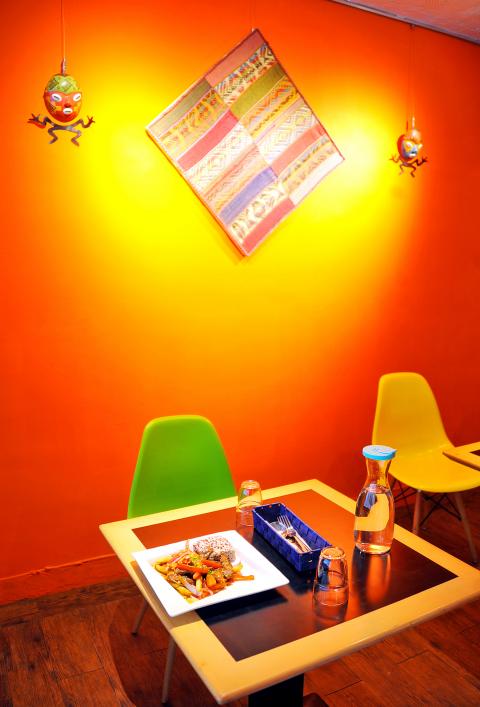
Photo: Han Cheung, Taipei Times
The restaurant is run by a Peruvian and Taiwanese couple who met in Cusco, with the Peruvian husband in charge of the cooking. The country’s cuisine is an amalgamation of various influences, ranging from indigenous to Spanish to Chinese. Some of the most common Peruvian dishes are relatively modern creations by immigrants: the ubiquitous pollo a la brasa, or chargrilled chicken, was developed in the 1950s by two men from Switzerland, while lomo saltado is a beef fusion dish created by Chinese immigrants at the turn of the 20th century. These are the two entrees we order.
The drinks menu is Peruvian as can be, including chicha morada, a sweet purple corn drink (NT$120); lemon juice with egg white (NT$120); Peruvian coffee (NT$120), pisco sour, the national cocktail (NT$200) and the country’s distinctive bright yellow-colored Inca Kola (NT$120). There’s also a chia seed (a “superfood” originating from Peru) lemonade (NT$140).
Even though I no longer drink soda, I feel compelled to order the Inca Kola for a nostalgic trip back to my time in South America. I never made it to Peru, but its cuisine was popular in Argentina where I resided. We also order the chicha morada.
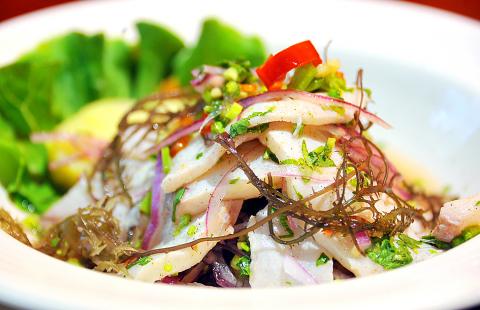
Photo: Han Cheung, Taipei Times
Created by a British resident in 1935, Inca Kola is another immigrant concoction turned national sensation. The taste is difficult to describe — very sweet and fruity, it falls somewhere between Coca Cola and cream soda. The distinctive ingredient is lemon verbena, a versatile plant native to Peru often used as a citrusy garnish in meat dishes, salad dressings and drinks.
The chicha morada is even more puzzling, having little corn taste, instead resembling flat cola or grape soda, with diced apple chunks floating on the top. The owner tells us that they added pineapple and lemon juice to a prepackaged chicha mix since the type of corn is difficult to obtain. I’m probably biased because I am not fond of overly sweet drinks, but it was not my favorite.
The meals come with a basic salad and soup with rice and quinoa. The ceviche (varies by market price, we paid NT$430) came first as an appetizer. Cured in lemon juice with a healthy serving of cilantro and onions, the first bite is very sour but in a light and refreshing way. The dish can be prepared with a number of seafood ingredients, but the star at Mama Inca is the cobia fish, which is firm and chewy. Sweet potatoes are added to balance the sourness, and the mushy texture adds an appealing dimension to the dish. It’s a great palate opener, even though it’s more expensive than the entrees.
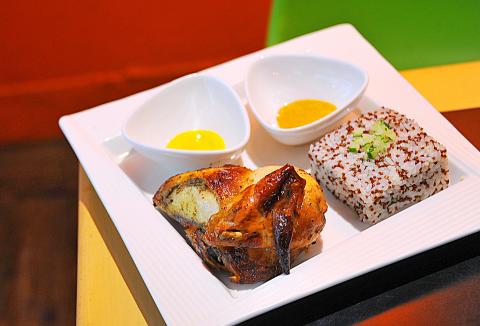
Photo: Han Cheung, Taipei Times
My friend ordered the lomo saltado (NT$300), stir-fried beef in a soy-and-vinegar based sauce with onions, tomatoes, bell peppers and french fries. The thinly-sliced beef is tender and juicy and the tomatoes and bell peppers provide the crunch and tang. But the most satisfying element were the french fries. Despite soaking in the sauce, the fries retained their crispiness, creating a sensation much like the American chili cheese version, but less thick. It came with a mixture of rice and quinoa, which has a crunchier texture than just plain rice.
I ordered the pollo a la brasa (quarter chicken for NT$200), which is served with the same rice and quinoa mixture and two dipping sauces — mustard and a spicy mayonnaise-like concoction.
The chicken was flavorful, grilled in typical Peruvian fashion. The outside was well-done with a savory layer of skin, but the inside was a bit dry without enough sauce to eat it with. Overall, the flavors paired well with the rice and quinoa, but it would have been better if the meat was juicier.
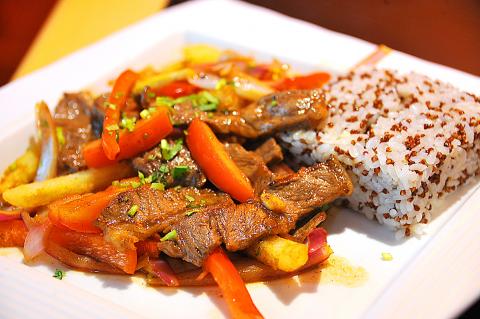
Photo: Han Cheung, Taipei Times
My friend wants to go again this week, and I plan on trying the aji de gallina (NT$340), which is shredded chicken with sauce made with peppers, walnuts and milk. And this time, she wants an entire ceviche portion to herself.
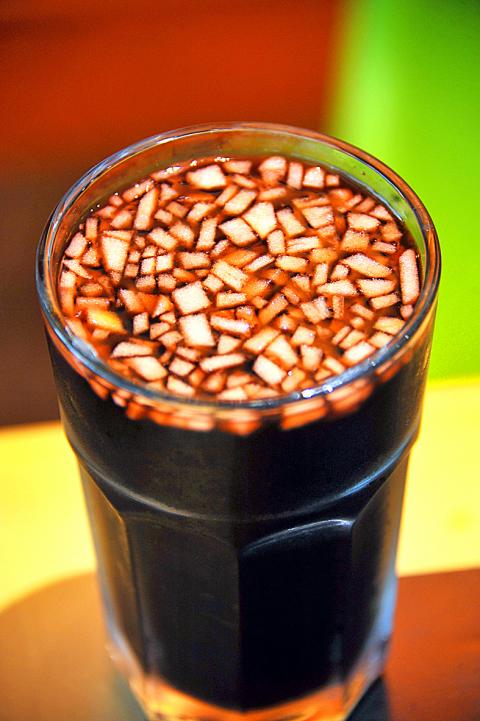
Photo: Han Cheung, Taipei Times

April 14 to April 20 In March 1947, Sising Katadrepan urged the government to drop the “high mountain people” (高山族) designation for Indigenous Taiwanese and refer to them as “Taiwan people” (台灣族). He considered the term derogatory, arguing that it made them sound like animals. The Taiwan Provincial Government agreed to stop using the term, stating that Indigenous Taiwanese suffered all sorts of discrimination and oppression under the Japanese and were forced to live in the mountains as outsiders to society. Now, under the new regime, they would be seen as equals, thus they should be henceforth
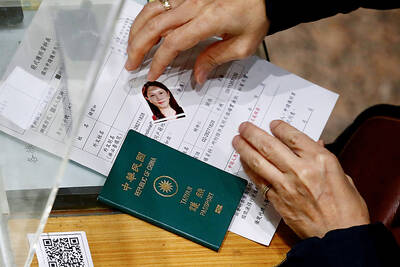
Last week, the the National Immigration Agency (NIA) told the legislature that more than 10,000 naturalized Taiwanese citizens from the People’s Republic of China (PRC) risked having their citizenship revoked if they failed to provide proof that they had renounced their Chinese household registration within the next three months. Renunciation is required under the Act Governing Relations Between the People of the Taiwan Area and the Mainland Area (臺灣地區與大陸地區人民關係條例), as amended in 2004, though it was only a legal requirement after 2000. Prior to that, it had been only an administrative requirement since the Nationality Act (國籍法) was established in

Three big changes have transformed the landscape of Taiwan’s local patronage factions: Increasing Democratic Progressive Party (DPP) involvement, rising new factions and the Chinese Nationalist Party’s (KMT) significantly weakened control. GREEN FACTIONS It is said that “south of the Zhuoshui River (濁水溪), there is no blue-green divide,” meaning that from Yunlin County south there is no difference between KMT and DPP politicians. This is not always true, but there is more than a grain of truth to it. Traditionally, DPP factions are viewed as national entities, with their primary function to secure plum positions in the party and government. This is not unusual

US President Donald Trump’s bid to take back control of the Panama Canal has put his counterpart Jose Raul Mulino in a difficult position and revived fears in the Central American country that US military bases will return. After Trump vowed to reclaim the interoceanic waterway from Chinese influence, US Defense Secretary Pete Hegseth signed an agreement with the Mulino administration last week for the US to deploy troops in areas adjacent to the canal. For more than two decades, after handing over control of the strategically vital waterway to Panama in 1999 and dismantling the bases that protected it, Washington has